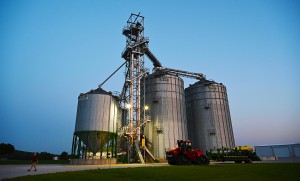This Week In Ag #121
The best days of my life were the day I got married, the day my sons were born, and the day we bought a big round hay baler. The past week’s extreme heat and humidity stirred up memories of what’s become a bygone era. We put up a fair amount of hay when I was kid in the 1970s and early 1980s, rotating alfalfa with corn, soybeans, oats and wheat; those crops feeding and bedding cattle and hogs, with their manure in-turn nourishing next year’s crops (today, I think they call that regenerative agriculture).
Making hay was certainly a full-on operation, involving nearly all family members, hired hands, and anyone else you could coax into working. This was not the easiest dollar one could earn. It is the pure definition of hard labor: continuously lifting heavy stacks in scratchy, itchy, sweaty, and sneezy conditions. And you never seemed to do it on a breezy, 70-degree day.
You’d cut it, hope it wouldn’t rain, rake it, hope it wouldn’t rain, then bale it into dense, rectangular cubes weighing 60-75 pounds. You had a tractor driver, usually an old timer or tough-as-nails farm girl, pulling the baler that hitched up a hay rack: a rackety, barely road-worthy wooden wagon with uprights on the back. Upon it stood my Uncle Gary, holding a giant metal bale hook resembling something that would make Michael Myers envious. He’d spear and grab the ejected bales and chuck them backwards, where a couple of guys would stack them on the wagon. When you made a full load, you’d switch to a new hay rack, and the full rack would be driven to the barn.
Now on most farms, the hay bales would be loaded onto an elevator that would mechanically carry the bales up into the haymow (the upper level of a barn, designed to hold hay and straw bales), where an awaiting crew of boys would pick them up and stack them within the upper recesses of the barn. But most farms did not have my dad. He was a haying beast. Much like Ralphie Parker’s “Old Man” did when he saw and smelled Christmas turkey, my old man’s eyes would glisten at the sight of fresh cut hay. It was his element. He spent his summers growing up not only baling for my grandpa but working on custom baling crews – experience he used to immediately impress his college football teammates.
Instead of placing bales on the elevator like a normal human, Dad would stand on the hay rack and just chuck the bales up into the mow at a rate faster than the crew could keep up. In those days, I was relegated to the haymow, where I held my own. Unlike Dad, I was more ambivalent when it came to hay season. It was just another chore that needed to be done, so I did it without giving much thought.
Each summer, we’d recruit boys to work in the mow. Half wouldn’t show up on the second day; by week’s end, we had a skeleton crew. The only city boy I recall ever making it through the season, who actually became a regular for us, was my buddy Tommy Worden, who later served in Iraq. He says he was groomed for those harsh elements by his hay experience.
But all this nostalgia ended the day dad brought that yellow Vermeer round baler to the farm, pulled by an IH 986 tractor with air conditioned cab. I was in high school at the time. Overnight, it transformed a labor-intensive operation and a rite of passage into a simplified task. Dad would run the baler, popping out 1,200-1,500 round bales, which would feed our cow herd for one day in the winter. Instead of stacking bales in the mow, I’d hook a bale tote to the utility tractor, carry the bales to the barnyard, and stack them in a line.
These days, the majority of hay is produced in large round or square bales, save for hobby cattlemen and horse enthusiasts. You might say the round baler foretold today’s modern farming, where integrated technology has replaced intense labor, along with the sweat, physical aches, and sense of community that goes with it. Not that I necessarily miss those steamy, dirty days in the mow, mind you. But the camaraderie felt during breaks between loads, when Grandma served us her homemade lemonade under her willow tree, will forever be etched in my heart.
Related Posts

This Week in Ag #46
A new year brings new hope and new predictions. Gazing into my crystal ball, here’s what’s taking shape in 2024: “Just in time” fertilizer application will continue. Granted, I still saw lots of knife-marked farm fields across Illinois while I was home for the holidays. But the practice of applying nutrients exactly when they are

PS Article Published in Tri-State Seminar Proceedings
An article by Heather Jennings, PE, Director of Probiotic Solutions®, has been published in Tri-State Seminars Magazine, the proceedings of the 36th Annual Tri-State Seminar, held on August 9–12, 2021, in Las Vegas, Nev. Ms. Jennings was a featured presenter at the seminar, which provides training and certification classes to educate water professionals from Arizona,

Are You Using Wastewater Bioindicators?
By Jael Batty Water quality can be evaluated quickly, efficiently, and cost-effectively through the use of bioindicators. The presence and activities of microorganisms can indicate changes in system operations and point to the source and magnitude of an issue.1 Protozoa Approximately 4% of the microorganisms in wastewater are protozoa, which are single-celled aerobic microorganisms. Protozoa

